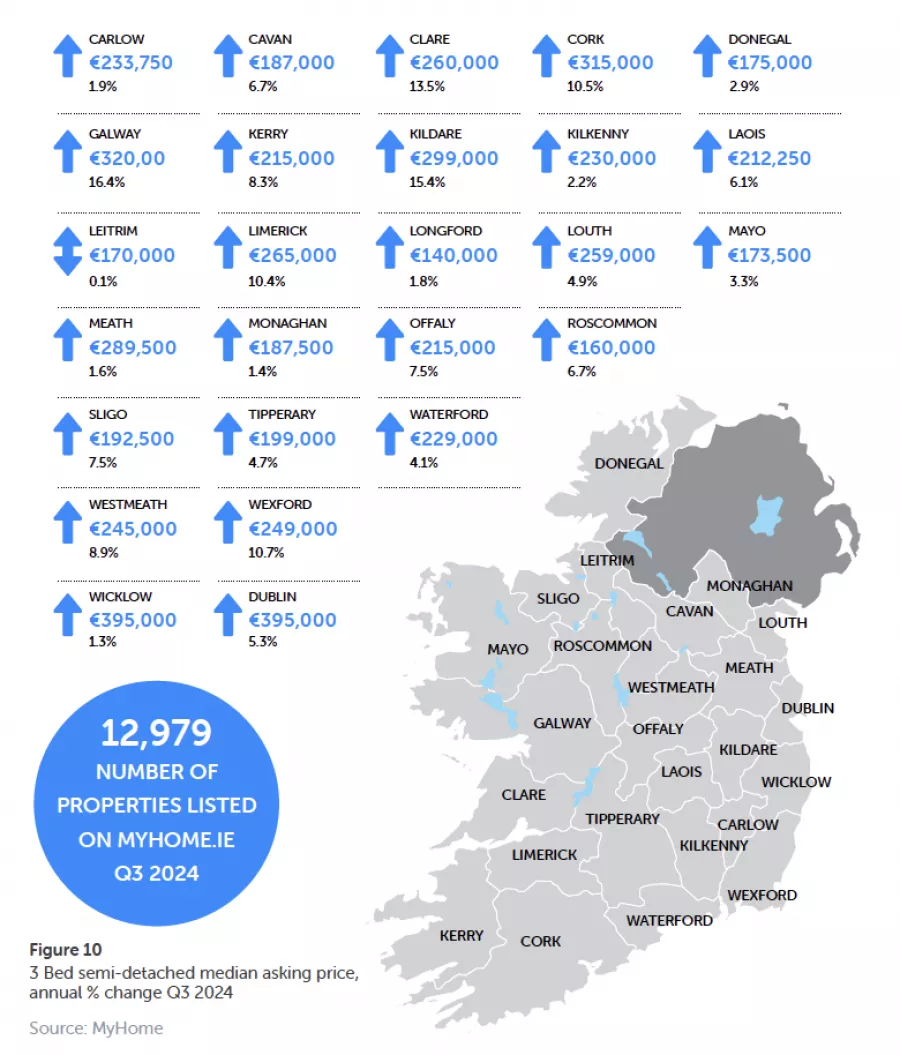Strong national growth putting intense pressure on housing market
Ireland would need to deliver an additional 206,000 homes this year alone to match the UK’s housing to population ratio, according to the latest quarterly house price report from MyHome in association with Bank of Ireland.
This figure is rising rapidly; in 2020, Ireland would have needed 138,000 extra homes – 68,000 fewer than this year – to match the UK’s market in relative terms.
The Q3 2024 report shows the Ireland’s exceptional population and labour market growth has put intense pressure on the housing market, which is seriously under-supplied.
The MyHome report for the third quarter found that annual asking price inflation was 7.5% nationwide. The last time this annual figure was higher was in Q3 2022, when inflation was 7.8% nationwide. Annual asking price inflation in Dublin is now 6.2% and the rate has accelerated to 8.5% in the rest of Ireland.
Meanwhile, the report found asking prices rose by 0.8% on the quarter nationally, by a marginal 0.3% in Dublin and by 1.2% outside the capital.
This means the median asking price for new instructions nationally in the quarter was €365,000. In Dublin it was €455,000 and elsewhere around the country it was €315,000.
Other findings include:
- Pay growth in Ireland is running at 5.6%, allowing homeowners to borrow more.
- As a result, average mortgage approval values have risen to a fresh record high of €318,300 – up 6.2% on the year.
- Properties are being sold for 7% over the original asking price, with 14% of transactions settling for at least 20% over asking.
- The average time to sale agreed was just 12 weeks in Q3, still close to a historic low.
- Residential transaction volumes in H1 were down 5% on the year, despite strong demand – signalling the lack of available stock is holding back demand.
- The number of properties listed for sale on MyHome in September was just 13,100, still well down from pre-pandemic levels.
- Housing starts have risen to 49,000 in the twelve months to July, and we expect completions to rise sharply in 2025 – to above 40,000 units.
- The rate of rent inflation has softened to 4% on the year.
Analysis:
The author of the report, Conall MacCoille, Chief Economist at Bank of Ireland, said: “Perhaps the most striking news since our last MyHome report is that Ireland’s population grew by 1.9% pace for a second successive year, to 5.38 million in 2024. We have not seen population and economic growth at this level since the Celtic tiger era, and as a result the housing market is being put under intense pressure.
“A simple way to illustrate this is to ask how many homes Ireland would need to build to match the UK’s housing to population ratio. Our report shows that to ‘catch up’ with the UK’s housing stock would now require an additional 206,000 homes, versus 138,000 in 2020.”
He added: “New instructions for sale in Q3, were up 2% on the year, but remain depressed. The overarching concern is that the tight housing market is now feeding on itself, with would-be vendors put off by for fear of failing to secure a property once they sell their own home.
He said that despite extremely challenging market conditions, with intense demand and a sustained lack of adequate supply, it was promising to see housing starts rise to 49,000 in the year to July. “However, the rush of activity prior to the expected expiry of waivers on local authority development levies and infrastructure charges means it is hard to gauge when these starts will translate into completions. Still, housing activity has held up far better than expected to the threat to viability from build cost inflation and elevated energy costs.”
He concluded: “The broad message from the MyHome asking price data is that the CSO’s official measure of house price inflation, based on transactions, looks set to peak in the coming months. That said, residential property price inflation was 9.6% in July, ahead of our MyHome figures, because homebuyers are increasingly paying over and above the original asking price. Nonetheless, we still expect RPPI inflation to fall back in the coming months, and finish 2024 at 7.75%.”
Looking ahead to 2025, and noting another expected cut to ECB rates, Mr MacCoille said another mid-single digit price gain looks likely.
Joanne Geary, Managing Director of MyHome, said: “It is heartening to see housing starts continue to rise as well as expectations that housing completions will exceed 40,000 units next year. This is the kind of trend we will need to see for years to come to redress the imbalance in the market, as epitomised in this latest report by our performance relative to that of the UK.”









